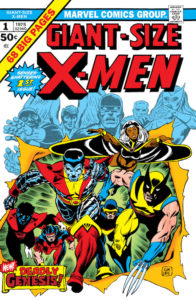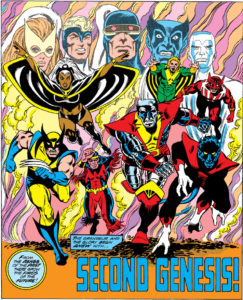
“Come mothers and fathers
Throughout the land
And don’t criticize
What you can’t understand
Your sons and your daughters
Are beyond your command
Your old road is
Rapidly agin.’”
(“The Times They Are A-Changin,'” Bob Dylan)
Introduction
In this article, we are going to take a closer look at the first couple of issues of Chris Claremont’s run on the X-Men. We start with the giant-sized X-Men #1 and then continue with X-Men #94 to #110. I think #110 is a good point to end the discussion because it is a so-called inventory issue. It is a fill-in issue by guest artist Tony DeZuniga. After that issue, John Byrne takes over as the artist until #143.
According to Joseph Darowski (2011), the reason for a relaunch of the X-Men was not as pure-hearted as one might hope. They merely wanted to sell more comics internationally, and Roy Thomas (editor-in-chief of Marvel) suggested that they use the X-Men. As you know, the X-Men were in reprints at that time, and they could relaunch it easily. Len Wein and Dave Cockrum became the writer and artist of the new incarnation of the team. But, as Thomas puts it, the idea of an international team got a bit lost in the process. The new members where, among other things, from Kenya and Russia, “hardly markets where Marvel was selling lots of comics in 1975.”
You may hear or read different versions of this story – depending on whom you ask, but it is very likely that the people at Marvel were interested in a more ethical reason for relaunching the X-Men, than just making more money.
Regardless, the X-Men were reborn. And beginning with issue #94, Chris Claremont started his seventeen-year reign of the X-Men. During this period he wrote almost every script of the X-Men, launched spin-offs, limited-, and maxi-series, and created characters and wrote stories, whose impact can still be felt today. At first, the comic series was published bi-monthly, beginning its monthly run with issue #112.
A New Beginning: Giant-Sized X-Men #1
“Which brings us to our next little problem… what are we going to do with thirteen X-Men?” – Angel
 Though Chris Claremont is not credited as being a part of the team, it is said that he was part of the relaunch. But who are those new X-Men, and how were they assembled?
Though Chris Claremont is not credited as being a part of the team, it is said that he was part of the relaunch. But who are those new X-Men, and how were they assembled?
Conveniently, the original mutants all disappeared during a mission on the mysterious island of Krakoa (a name which should ring some readers’ bells). They were investigating some strange signs and just vanished, only Scott survived to bring the horrible news to the Professor. In response, Xavier starts a journey around the world to gather a new team of mutants. They should not only save the original X-Men but also become part of them.
“This new team members were Nightcrawler (a German teleporter named Kurt Wagner), Storm (Ororo Munroe, a weather controller from Kenya), Colossus (the Russian Peter Rasputin who could turn his flesh to steel), Banshee (the Irishman Sean Cassidy who had a sonic scream), Warpath (John Proudstar, a Native American with super‐strength), Sunfire (a fire‐wielder from Japan named Shiro Yoshida), and Wolverine (the Canadian with claws and a healing factor known only as Logan). Not all of these characters would remain X‐Men for long, but this relaunch firmly established the X‐Men as a team that embraced international characters in a way that other Marvel superhero teams, such as the Avengers or the Fantastic Four, rarely have” (Darowski, 2011, p. 123).
As the new team lands on the island, it turns out to be a mutant in itself, created by accident via an atomic explosion, of course (a remnant of the atomic age of comic books?). They defeat their enemy with the combined strength of Storm and Lorna Dane. And, the Professor helps to distract the mutant island while they prepare their attack. It is the first sign that this new iteration does some things differently. Two women save them all. In past issues, this would not have been possible. At this point, Jean does not play a very active role in the story, something that will be corrected in upcoming storylines.
I want to point out two things that bothered me a bit. First, Ororo is a god to the indigenous people where she lives. They pray to her and count on her aid if need be. To control every part of the weather and make it rain in a matter of seconds can be a powerful weapon and seem very god-like. The narrator says that “her liquid eyes grow dark” when she uses her powers, which is a powerful image in itself. Unfortunately, in the artwork, her eyes are shown as being plain white (they become white in the movies as well).
My second issue is the recruitment of Colossus. The story of his first encounter with the Professor is a bit far-fetched. His sister is in danger of being run over by a tractor in an open field. Tractors can be very loud; how can you be driven over by them? She just sits in the field and does nothing. Then, when Peter has her in his hands, he just stands there and destroys the vehicle. He could have just jumped out of the way. The author could not come up with a better story to introduce us to Peter’s powers?
Either way, the new team is assembled and…
 “There was not a single white American among the new members of the team, and many of the minority groups represented had been the subject of widespread prejudice in the United States, much of it institutionalized by the government. Germans were mistrusted after World War II and the well‐publicized horrors of the Holocaust. Africans have a long history of suffering from prejudice in America beginning with the slave trade. The general feelings toward Russians during the Cold War were far from friendly, and having an Eastern European accent could lead to accusations of Communism. Anti‐ Irish sentiment was strongest in the mid‐1800s in the United States when discrimination in the workplace included the posting of NINA signs in want ads (No Irish Need Apply). Native Americans have been mistreated within the United States since settlers first reached the country’s shores, and the forced movement onto reservations is only one of a long list of grievances. During World War II the federal Government forced Japanese Americans to live in internment camps because of mistrust” (Darowski, 2011, p.125-126).
“There was not a single white American among the new members of the team, and many of the minority groups represented had been the subject of widespread prejudice in the United States, much of it institutionalized by the government. Germans were mistrusted after World War II and the well‐publicized horrors of the Holocaust. Africans have a long history of suffering from prejudice in America beginning with the slave trade. The general feelings toward Russians during the Cold War were far from friendly, and having an Eastern European accent could lead to accusations of Communism. Anti‐ Irish sentiment was strongest in the mid‐1800s in the United States when discrimination in the workplace included the posting of NINA signs in want ads (No Irish Need Apply). Native Americans have been mistreated within the United States since settlers first reached the country’s shores, and the forced movement onto reservations is only one of a long list of grievances. During World War II the federal Government forced Japanese Americans to live in internment camps because of mistrust” (Darowski, 2011, p.125-126).
Before we leave the Giant-Sized relaunch, here are some irrefutable facts:
- The school of Xavier is placed in Westchester, New York.
- We already get a sense of a bigger universe as the Professor tells his new students about their new costumes: “I obtained them from a man named Reed Richards.”
- Hank apparently graduated from the X-Men and now works with the Avengers (and he finally is blue and furry).
Storytelling and Artwork
In looking at the first seventeen issues of Chris Claremont’s run, it already feels more like a continuous story than the previous incarnations. Kirby and Lee’s run reminded me of your typical crime TV show, with case-of-the-week-style storytelling. While the Thomas-Adams run already had this continuous story idea, Claremont perfects it. At first, we get smaller storylines, but they are so nicely connected with vacations, goodbyes, and other things, that it feels like one big act.
The story in every issue also feels more natural, because the narrator, the conversations and the things shown in the panels themselves are not repetitive. Everything adds to a grander scheme. We get more information on these separate levels, be it thoughts, context or personal background. It is very little that’s said and/or shown twice. This is especially true in later issues.
The narration is used to describe things you cannot explain in a picture or at least not quite as well. The Phoenix power (we will talk about this in detail later) is a complicated matter on many different levels. So you have to take the images and then use the text to add some sort of meta-level to it. I was looking forward to seeing the Phoenix power in action for the first time, and I didn’t think it would be possible to have such a complete experience of it.
Without repetitions, lot more happens in one issue than ever before. Just to give you a brief summary of the most important cornerstones:
- We begin our journey at a military base, where the X-Men face Count Nefaria and his Ani-Men (they apparently fought them before in issues number 22 and 23). Back at the mansion they encounter a mythical creature released by accident by Scott. After that some X-Men leave, but their departure at the airport is interrupted at the airport by Eric the Red (another recurring villain; they fought him in issues number 51 and 52). The X-Men want to celebrate Christmas, but the only presents they get are some Sentinels. They attack the X-Men at the Christmas Market.
- For the 100th issue, we get a fight we did not anticipate: X-Men vs. X-Men in a space station. During the reentry Jean tries to save everyone from dying. In the process, she kills herself, is reborn, and discovers her Phoenix power. After all that, the team deserves a vacation, right? Well, in Ireland (where, of course, leprechauns live) at Banshee’s home castle they encounter his brother and Juggernaut. Back at home, Jean, her parents, her new roommate, and the Professor are being attacked by Firelord. They are taken to another planet, fight a part of the Shi’ar empire, meet the Starjammers, fight some guardians, and save the universe.
- Back on earth, Wolverine is being hunted by his former employer and last, but not least a new more significant threat is introduced through Warhawk in the inventory issue (#110).
The New X-Men
“I’m an X-Man, pure and simple. This is my home, my life. This is where I… belong.” – Scott
In addition to all those great stories, we get to learn a lot about our new heroes: their struggles, fears, where they are from and what they have endured so far. We get new relationships (Banshee and Moira), as well as some tragic deaths (John Proudstar) and X-Men leaving the team (Bobby, Lorna, Alex, Sunfire).
This leaves us with one important questions: what does Chris Claremont tell us about the new X-Men and is it always consistent within the story?
- Nightcrawler: He plays time and time again a vital part in the stories, especially in his interesting relationship with Scott. At one point, as they return from their space trip, he confronts Scott and wants him to open up. Scott misinterprets Nightcrawler’s invariably good mood as having a good and comfortable life. But he is blue, furry, and has a tail. Scott seemingly does not perceive those features as strange or unusual. They are part of Nightcrawler, as the visor is part of Scott. In reaction to this misinterpretation Kurt talks back very harshly, but, before they can have a real conversation, Banshee comes into the room. I am curious where this relationship goes in the next issues. Regarding his powers (e.g. teleportation), he says, that he keeps his momentum. However, we don’t really see this very often, especially during fights. This is something I miss most. The first time I saw this character was in the second movie with the brilliant fight scene in the White House. When used correctly, he is one of the deadliest fighters. Maybe he is still learning. Also, he has apparently never teleported two people before. So, we have to be patient with him.
- Ororo: During a fight between Colossus and the Juggernaut, Ororo just lies in a dark corner, paralyzed by her fear (claustrophobia). In a flashback we see how she was raised or at least some highlights of it. Her parents moved to Cairo when she was six months old. There she grew up like an average kid, but, at the age of five, her parents were killed. This happened in 1956, the year of the Suez War. A damaged aircraft is hit and falls from the sky, striking the area where Ororo’s family lives. She barely survived and lived on the streets until a man named Achmed El Gibàr took her in. He showed her how to survive. One day she left and walked to the Serengeti Plain, her natural home. She learned to forget her past, but the claustrophobia brought everything back.
- Colossus: The most tragic thing we learn from him is that his brother Mikhail, a Russian cosmonaut, was killed by an accident. His rocket exploded.
- Wolverine: One time he briefly mentions his troubled past, but nothing specific. In this issue (#98) he uses his claw for the first time without the uniform. His comrades thought they were in the costume and not part of him (a reminder that you, as a reader, can get used to something buthave to keep an open mind when reading something like this for the first time).
One thing I don’t want to talk about (mainly because I am not sure I understand it all correctly) is the thing about the Shi’ar empire. The Professor has Visions of Princess Lilandra, who is being hunted by her own brother, the emperor. She seems to have psychic powers as well and connects with him. The X-Men are drawn into this conflict by issue #105. I highly recommend reading this issue and the storyline. Personally, I find it to be the first real strong point of Claremont’s storytelling. I like it because of its complexity. The story shows what comics are able to accomplish, when done right.
Friend or Foe
At first, the X-Men have to deal with villains they encountered before. New ones are introduced later in the series.
Dr. Steve Lang may be one of the most terrifying antagonists of this first couple of issues: “My goal has always been not the investigation of mutantkind–but its total, complete extermination!”
 His inspiration comes from Bolivar Trask, the man behind the Sentinel program. He plans genocide, plain and simple. There is no nice way to say this: genocide, every mutant. Every woman, every child, and every man with mutant abilities should be destroyed by his Sentinels. We already talked about this topic, and we will talk about it again in upcoming articles, but I wanted to mention it here as well, just to give you an idea, of how rooted this kind of mindset is in this universe. There will always be people who want to destroy not only the X-Men but the entire mutant race.
His inspiration comes from Bolivar Trask, the man behind the Sentinel program. He plans genocide, plain and simple. There is no nice way to say this: genocide, every mutant. Every woman, every child, and every man with mutant abilities should be destroyed by his Sentinels. We already talked about this topic, and we will talk about it again in upcoming articles, but I wanted to mention it here as well, just to give you an idea, of how rooted this kind of mindset is in this universe. There will always be people who want to destroy not only the X-Men but the entire mutant race.
Another vital villain in these issues is Eric the Red. He orchestrates a lot of the plots against the X-Men and plays a crucial part in Lilandra’s mission. The first time we meet him (issue #97), the X-Men (Jean, Scott, Kurt, Ororo, and Colossus) say their goodbyes to the Professor at the airport. They are attacked by Havoc and Polaris, who have been manipulated by Eric the Red. The Professor can escape with the plane, but the others stay and fight their foe. In an editor’s note, we get the information that the team had encountered Eric the Red before (in issues #51 and #52). The weird part, at least for me, was to find out that Scott formerly portrayed the character (encouraging us to read the issues we skipped as well).
Eric is able to escape with his new team members Havoc and Polaris (can he control their minds?), and he appears alone later in issues #104 and #105. Eric infiltrates the mansion, works with Magneto, and manipulates Firelord to help him as well. Firelord does not know the relationship the X-Men have with Eric, so it is easy for him to play the victim and manipulate the former herald of Galactus.
Of course, the X-Men attack Eric immediately, reinforcing his point that the X-Men want to conquer the world. This shows the premonition of Eric the Red to be correct. He knows the weaknesses of his opponents and manipulates others to help him. His real name is Shakari, and he works for Lilandra’s brother, the emperor. Shakari builds a Star-Gate (the inspiration for another magnificent sci-fi show?) to take her back to her brother, where she is to be killed. The X-Men fight their opponents bravely but Shakari and Lilandra escape. Jean fights off Firelord and is then able to activate the Star-Gate again, so the team can follow them.
Conclusion
“There was no need for worry, Scott. I have total control over my abilities–nothing was harmed save the Sentinel” – Ororo.
“The Times They Are A-Changin'” indeed. Jean has done more in these few issues than in the entire 60+ issues before. Ororo is a god among her people, and Moira is a great new character with depth, and a lot of secrets are to be uncovered. Even female side-characters get awesome, badass moments. Take Jean’s new roommate for example. When Firelord attacks them in their apartment, Misty draws a gun and threatens him.
But that’s just the tip of the iceberg. Jean fights against Firelord as the Phoenix and discovers that her new powers are so extraordinary that she will fall into a rage if she is not careful enough. The Phoenix within her wants to kill Firelord and not listen to Xavier when he talks to her about her fellow X-Men. But she can control it, for now at least.
Every story, every character, and every panel of Chris Claremont’s first run screams “new era.” However, it is not perfect, nothing is, as there are some really ridiculous parts as well. Take the leprechauns in Ireland, for example, or the fact that we get to know that Magneto, in a side-story in Defenders #16, was turned into a baby and saved by Eric the Red. It’s the 70’s/80’s era of comic books, and some parts had to be weird, crazy and a bit over the top. But, that doesn’t make it any less exciting.
Next month we take a closer look at issues #111 to #124, as well as the first, king-size annual. And next week we talk about the mutant metaphor.
Sources
- Darowski, J. (2011). Reading The Uncanny X-Men: Gender, Race and the mutant metaphor in a popular narrativen (Doctoral dissertation). Retrieved from https://etd.lib.msu.edu/islandora/object/etd%3A1030



